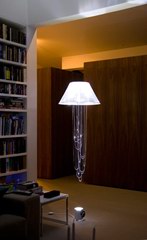1. Three Representations of the Color of Light
- International Commission on Illumination Chromaticity Diagram Representation
- Color vividness of light
- Color temperature or correlated color temperature
They will be introduced one by one below.
International Commission on Illumination Chromaticity Diagram Notation
The International Commission on Illumination (CIE) proposed the XYZ chromaticity diagram in 1931, and in 1960 proposed the UCS chromaticity diagram based on the XYZ chromaticity diagram.
Color perception is the result of the action of the human eye on a source of optical radiation or optical radiation reflected by an object. Therefore, color depends not only on light stimuli, but also on the visual properties of the human eye.
Measurements and standards regarding color should match what the human eye observes. However, the color characteristics of the human eye are more or less different for different observers. Therefore, it is required to determine a set of three primary color data matching the isoenergetic spectral colors according to the color vision experiments of a large number of observers. That is, the “standard chromaticity observer spectral tristimulus value”, which represents the average color visual characteristics of the human eye and is used for chromaticity measurement and calculation.
In 1931, CIE established the CIE1931 chromaticity diagram by using the envisaged three primary colors X, Y, and Z (representing red, green and blue, respectively) on the basis of the RGB system. This graph is a normalized graph. As long as the X and Y values are marked, the value of Z can be known (Z=1-(X+Y)), so the chromaticity diagram of three variables becomes the plane diagram of two variables of X and Y .
Light Color Vibrancy
The color vividness of light must be expressed by the dominant wavelength λd and color purity of light. At present, LED chip suppliers all use the dominant wavelength λd to express the vividness instead of the peak wavelength λp.
Dominant wavelength λd:
AB in the chromaticity diagram is the black body locus. Let F point be the coordinates of a light source in the chromaticity diagram, and E point be the reference light source point of ideal equal-energy white light, which is (0.3, 0.3) in the chromaticity diagram. Connecting point F by point E and extending to point G, the monochromatic wavelength corresponding to point G is called the dominant wavelength λd of point F light source.
Peak wavelength λp:
The corresponding wavelength at which the spectral luminous intensity or radiant power is maximum. It is a pure physical quantity and is generally used in the detection of monochromatic light with a relatively symmetrical waveform.
Central wavelength:
The wavelength corresponding to the center point of the half-width of the main peak when the main peak and the secondary peak appear in the spectral luminous intensity or radiant power. It is generally used in the detection of concave and poor-quality monochromatic tubes near the normal direction of the light distribution curve.
Color purity Pe:
Pe=EF/EG. If the coordinates of point F of a certain light source in the chromaticity diagram are closer to point G, then the lengths of EF and EG are closer to the same, and the closer Pe is to 1, the higher the color purity.
In layman’s terms, color purity refers to the degree to which the color coordinates of the incident light are close to the spectral locus on the CIE1931 chromaticity diagram. The closer you are, the higher the purity. So, if the color coordinates are on the spectral orbit, the color purity is 100%. Conversely, the purity of white light with equal energy is 0%. Color purity is also a physio-psychophysical quantity.
Half width:
The width at half of the spectral luminous intensity or radiant power maximum (FWHM), or “bandwidth” for short. The smaller the bandwidth, the purer the color, and obviously it is also a pure physical quantity.
Color Temperature or Correlated Color Temperature
Color temperature
The use of white light in the field of lighting is generally expressed by color temperature or correlated color temperature. Sometimes people also use color coordinates. The color of the light source has two meanings, namely color table and color rendering. The color table is the perception of color when the human eye directly observes the light source. The objective effect of light irradiating on an object, that is, the ability of the light source to make the color of the illuminated object appear again, is called the color rendering of the light source.
The color of light emitted by the light source can be represented by the color temperature Tc. When the color of the light emitted by the light source is the same as the color radiated by the black body at a certain temperature, the temperature of the black body is called the color temperature of the light source, or color temperature for short.
When the energy distribution of the spectrum is similar to the relative spectral energy distribution of the black body radiation at a certain temperature, its color must be the same. Therefore, the distribution temperature must be the color temperature. For example, the color of the light emitted by incandescent lamps and tungsten halogen lamps can be expressed by color temperature.
correlated color temperature
But for gas discharge light sources, the spectral energy distribution is rarely similar to that of a black body. Therefore, the distribution temperature of these light sources can only be called correlated color temperature. For example, black body tungsten filaments above 2000°F (1°F = 0.555556K) radiate the same color as the light emitted by the candle when it is lit. Then, the temperature of the tungsten wire above 2000°F is called the color temperature of the candle light.
The method for calculating the correlated color temperature of a certain light source is: in the CIE1960UCS chromaticity diagram, the coordinate point representing the color of the light source is drawn perpendicular to the black body and white track, and the color temperature of the black body at the intersection with the white track is the correlated color temperature of the light source.
In general, people refer to high color temperatures as cool colors and low color temperatures as warm colors.
2. Indicators Related to the Intensity of Light Radiation
Relative visual acuity function V(λ) curve
For light with different λp, even if the light power is the same, the light intensity felt by the human eye is still different. The human eye has the highest sensitivity to green light with λp=555nm, and the sensitivity to the wavelengths on both sides of this value is getting lower and lower.
When λp<380nm or λp>780nm, no matter how strong the light energy radiation of the light source is, the human eye does not feel any light for it. For example, in the relative visual acuity function curve, the infrared rays at 850 nm, 880 nm and 940 nm cannot be seen by the human eye at all.
The V(λ) curve is recommended by the International Commission on Illumination research. When λp=555nm, V(λ) is the maximum value of 1.0. And when λp=460nm, V(λ)=0.06. When λp=660nm, V(λ)=0.0608.
Luminous flux—φ
Luminous flux is a measure of the radiant power of light according to the perception of light by the human eye. That is, the effective equivalent of the part of the radiated optical power that can be felt by the human visual system. The symbol of characterization is φ, and the international unit of luminous flux is lumen (lm).
Assuming that the wavelength of monochromatic light is λi, the luminous flux F(λi) of this wavelength is equal to the product of its radiant power P(λi) and the relative visual acuity function V(λi), as shown in formula (1):
F(λi)=P(λi)×V(λi) (1)
If the radiant power spectrum of the light source is Px(λ), the total luminous flux F(λ) should be the sum of the luminous flux of each wavelength component.
P(λ) is the optical radiation power at a given wavelength in W. V(λ) is the relative visual acuity function for a given wavelength. The maximum lumen efficiency Km is 683lm/W (when λp=555nm).
Lumen Efficiency
The human eye is limited by visibility, so light has different maximum lumen efficiencies for different λp:
When λp=555nm: the maximum lumen efficiency (Km) is 683lm/W.
- When λp=470nm: V(λ)=0.0913, the maximum lumen efficiency is 683×0.0913=62.40lm/W.
- When λp=460nm: V(λ)=0.06, the maximum lumen efficiency is 683×0.06=41.00lm/W.
- When λp=450nm: V(λ)=0.038, the maximum lumen efficiency is 683×0.038=26.01lm/W.
When λp=660nm: V(λ)=0.0608, the maximum lumen efficiency is 683×0.0608=41.5lm/W.
- When λp=650nm: V(λ)=0.107, the maximum lumen efficiency is 683×0.107=73.081lm/W.
When λp=620nm: V(λ)=0.381, the maximum lumen efficiency is 683×0.381=260.223lm/W.
The maximum lumen efficiency of white light composed of different light sources varies due to different reasons for the visibility of the human eye. The maximum lumen efficiency in the middle color temperature area will be higher, while the maximum lumen efficiency in the high color temperature area and the low color temperature area will be lower. So for different color temperature, its lumen efficiency will be different.
To improve the light efficiency of white LEDs, the wavelength of light radiated by the LED and the spectrum of the YAG phosphor should be considered. The current YAG phosphors have λp=530nm, 540nm, 550nm, 560nm, 570nm, and the bandwidth is different.
When the blue LED excites the yellow YAG phosphor to form white light, although the radiated blue light energy is lost, the maximum lumen of the excited yellow light is several times higher than that of the blue light. Therefore, the lumen efficiency perceived by the human eye is improved.
Luminous Intensity I
The luminous flux emitted by the light source within the solid angle dΩ in the specified direction or the luminous flux dφ transmitted by the obtained light source, the quotient of the two is the luminous intensity I (unit is candela, cd):
I=dφ/dΩ (3)
1 cd=1 lm/sr (lumens/stereoradian)=1 candle light
If the total luminous flux emitted by the light source to the space is φ, since the total solid angle of the light source is 4π, the average light intensity Iθ=φ/4π. The distribution of actual light intensity in all directions of space is not uniform, and the curve of spatial light intensity distribution is called light distribution curve.
Brightness L
The brightness L of a point on the light-emitting surface of the light source (unit: cd/m2) is equal to the quotient of the luminous intensity obtained on a plane perpendicular to a given direction and the orthographic projection area, namely
L=dI/dScosθ (4)
The unit is nit (nt), 1nt=1 candle light / m2 = 1 cd/m2.
If the light from the light source is perpendicular to the measurement surface, then cosθ=1. For an ideal plane diffuse reflection light source, if the area of the light source is S and the luminous flux emitted to the sky is φ, then there is a light intensity I=φ/2π (because of the upward emission, there is only 2π):
L=I/S=φ/2π·S (5)
Illuminance E
The illuminance E of the light source (unit is lux, 1 lx=1 lm/m2), that is, the quotient of the luminous flux dφ of the light source on the surface of an object and the surface area dS, expressed as
E=φ/S (6)
For a point light source, if the light intensity in a certain direction is I, then the illuminance at a distance r is
E=I/r2 (7)
Illuminance is inversely proportional to the square of the distance from the light source.
Semi-strong angle
The half-intensity angle is the so-called half-value angle, which is the angle between the center light intensity I and the surrounding I/2, which is the half-intensity angle. When the light intensity of the light source is uniform, the angles included when the surrounding light intensity deflected to the normal is half of the original should be equal. When the light intensity is not uniform, the included angles are not equal. There is a difference between a semi-strong angle and a viewing angle, and the viewing angle is generally larger. The light-emitting angle of the LED light source is also an indicator.










